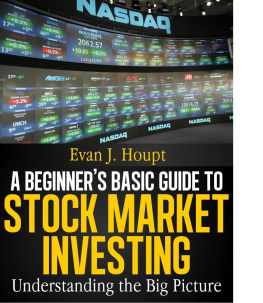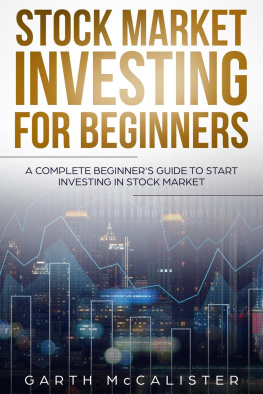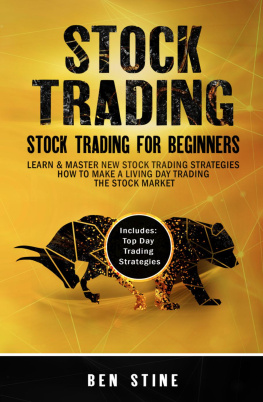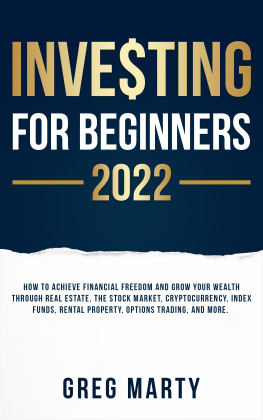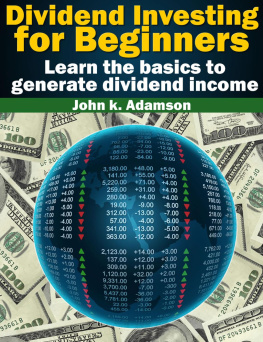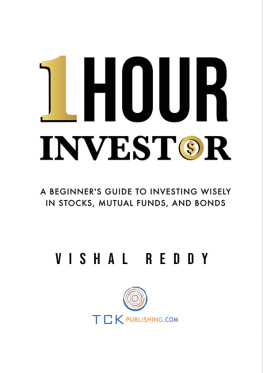A BEGINNERS BASIC GUIDE TO STOCK MARKET INVESTING: UNDERSTANDING THE BIG PICTURE
The Investing Series, Volume 1
Evan J. Houpt
Published by AKAMite Publishing, 2013.
While every precaution has been taken in the preparation of this book, the publisher assumes no responsibility for errors or omissions, or for damages resulting from the use of the information contained herein.
A BEGINNERS BASIC GUIDE TO STOCK MARKET INVESTING: UNDERSTANDING THE BIG PICTURE
First edition. August 26, 2013.
Copyright 2013 Evan J. Houpt.
ISBN: 978-1497798182
Written by Evan J. Houpt.
10 9 8 7 6 5 4 3 2 1
To My Father,
Arthur Houpt
Introduction
W hen I took an early retirement from my job as an engineer for one of the Big Three automakers eight years ago, I knew I wanted to try my hand at the stock market. I had a nice retirement package and years of savings built up. My wife, Nedra, and I owned our home free and clear. Our children were grown and their college was nearly paid for. The United States economy was doing decently. So I bought a couple of books on stock investing and plunged in.
I know youre thinking, Whats next? Youre wondering if I figured out how to beat the market and became a millionaire. Or the more pessimistic of you are wondering if I bet our life savings on a dud IPO and lost everything.
The answer is neither. I didnt figure out how to beat the market, although I wasted a lot of time and energy trying to. And I didnt bet the farm on my stock investments. Even if I had been dumb enough to do that, Nedra would have brought me up short in a big hurry.
The biggest challenge for me over the past eight years was simplifying the process. Ive read numerous books for beginning stock investors, and too few of them do a good job of explaining the big picture and where someone like me fits in. Plenty of books define investment terms like market cap, ETFs, and IRAs, but understanding those terms in isolation from each other didnt help me one bit. In my confusion, combined with my engineers tendency to overcomplicate things, I made a few beginners mistakes and worried far more than I needed to before making a decision.
But I persevered and learned, partly by studying, and partly by doing. I invested very conservatively and did a lot of practice investing on simulator websites until I felt more confident. As I learned more, I discovered that my background as an engineer gave me an advantage, and I found myself applying my analytical and math skills in a new way. Investing became fun and emotionally rewarding, as well as bringing me excellent financial returns.
This book is written for the beginning retail investor who wants an overview of the market in easily understandable terms and a clear explanation of how they fit together. My goal is to leave you with a practical working knowledge of the stock market with a minimum cost of time and frustration when you finish this book.
Apply what you learn here to develop your own investment style. Be creative and enjoy the process. Dont spend more time or money than you have, and if you find yourself worrying about your investments, remember that even the worlds greatest investors often call it wrong.
To your prosperity and enjoyment,
Evan Houpt
Chapter 1
Understanding Stocks
D uring my years as an engineer, I often spoke to my friends and my wife about investing in the stock market. In fact, I talked about it for years without really knowing what it meant. I had a vague idea in my mind, but I didnt understand the big picture until I retired and started actually investing.
To keep you from starting out with the disadvantage I had, lets look at the big picture of stocks.
Understanding Securities
To understand stocks, you should know what securities are, because a stock is a type of security.
A security is a financial instrument that has a certain monetary value and can be purchased or traded. There are two types of securities.
Debt securities are interests in a loan that a borrower agrees to repay to a lender, with interest are interests in a loan that a borrower agrees to repay to a lender, with interest. The most common examples of debt securities are certificates of deposit (CDs) and bonds. Bonds can be issued by private corporations as well as by government entities.
Equity securities are ownership interests in a company that issues them and allows them to be traded on the open market. Because the owner of the equity security actually owns a piece of the company, he gets part of the companys profit or loss. A stock is the most common type of equity security. Stocks are sometimes simply called equities. Stock owners are called shareholders, because they hold a share of the company.
Stock Classes
There are two types, or classes, of stocks you should be familiar with.
Preferred stock is a higher class of stock than common stock and provides extra benefits to the shareholder. Preferred stock holders often receive an extra return on their shares, called dividends. If the company goes out of business, preferred shareholders are paid first. However, preferred shares usually dont include voting rights. Some preferred stocks are classified as debt securities because their terms are so restrictive.
Common stock is a single class of shares, usually the largest class in the company. Some common stock pays dividends, but only after the preferred shareholders take theirs. Holders of common stock are the last to be paid for their shares in a liquidation. Common stock holders always have voting rights. As a retail investor, youll almost always be investing in common stock.
Voting Your Shares
Now, about those voting rights. When you buy stock in a company, youre a co-owner, so you receive the right to vote on large issues that affect the company. You get one vote for each share you own, so the more shares you own, the more your vote influences the company.
The largest issue before you as a holder of common stock in a company is voting for the board of directors. The board is the decision-making body of the company and is responsible for hiring and firing upper management, as well as major investment decisions such as mergers and buyouts. Sometimes shareholders also vote on very large matters of company policy, including compensation of executives. However, the business judgment decisions for the day-to-day operations of the company are in the hands of the board and the upper level managers.
Many individual shareholders dont vote their shares because they believe their votes dont matter if they only own a small percentage of the companys stock. I always vote my shares because its so easy, and I believe that if enough people vote, it makes a difference. Voting your shares doesnt require you to travel to corporate headquarters. If youre a shareholder, the company is required by law to send you a proxy voting statement, either electronically or by mail. Your vote is through a proxy, a real person who casts votes on your behalf as you direct. You can vote online, or by filling out and mailing back your proxy statement.
Shareholders can sell their stocks to other people, and they can buy stocks from other people. Thats called trading. Thats what this book is about, and thats where the fun begins.
Chapter 2
Stocks vs. Other Investments
S tocks are only one of many ways you can invest your income and receive a return. When I first started investing, I was entirely focused on stocks and made the choice without looking at alternatives. Fortunately, Im happy with my results, but if I had a do-over, I would compare stocks next to other investment vehicles and make a more informed decision.

